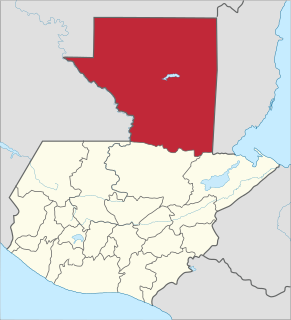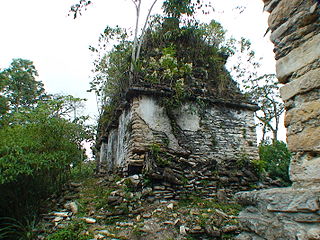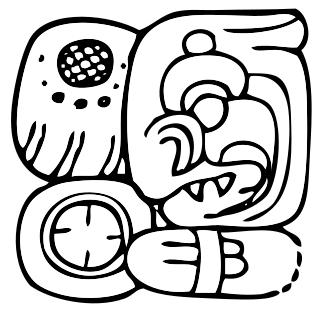
Petén is a department of the Republic of Guatemala. It is geographically the northernmost department of Guatemala, as well as the largest by area — at 35,854 km2 (13,843 sq mi) it accounts for about one third of Guatemala's area. The capital is Flores. The population at the 2018 census was 545,600.

Piedras Negras is the modern name for a ruined city of the pre-Columbian Maya civilization located on the north bank of the Usumacinta River in the Petén department of northeastern Guatemala. Piedras Negras is one of the most powerful of the Usumacinta ancient Maya urban centers. Occupation at Piedras Negras is known from the Late Preclassic period onward, based on dates retrieved from epigraphic information found on multiple stelae and altars at the site. Piedras Negras is an archaeological site known for its large sculptural output when compared to other ancient Maya sites. The wealth of sculpture, in conjunction with the precise chronological information associated with the lives of elites of Piedras Negras, has allowed archaeologists to reconstruct the political history of the Piedras Negras polity and its geopolitical footprint.

Yaxchilan is an ancient Maya city located on the bank of the Usumacinta River in the state of Chiapas, Mexico. In the Late Classic Period Yaxchilan was one of the most powerful Maya states along the course of the Usumacinta River, with Piedras Negras as its major rival. Architectural styles in subordinate sites in the Usumacinta region demonstrate clear differences that mark a clear boundary between the two kingdoms.

Piedras Negras is a city and seat of the surrounding municipality of the same name in the Mexican state of Coahuila. It stands at the northeastern edge of Coahuila on the Mexico–United States border, across the Rio Grande from Eagle Pass in the U.S. state of Texas. In the 2015 census the city had a population of 163,595 inhabitants, while the metropolitan area had a population of 245,155 inhabitants. The Piedras Negras and the Eagle Pass areas are connected by the Eagle Pass–Piedras Negras International Bridge, Camino Real International Bridge, and the Union Pacific International Railroad Bridge.
Piedras Negras may refer to:

Cancún is a city in southeast Mexico on the northeast coast of the Yucatán Peninsula in the Mexican state of Quintana Roo. It is a significant tourist destination in Mexico and the seat of the municipality of Benito Juárez. The city is on the Caribbean Sea and is one of Mexico's easternmost points.
The year 1939 in archaeology involved some significant events.

Jaina Island is a pre-Columbian Maya archaeological site in the present-day Mexican state of Campeche. A small limestone island on the Yucatán Peninsula's Gulf coast with only a tidal inlet separating it from the mainland, Jaina served as an elite Maya burial site, and is notable for the high number of fine ceramic figurines excavated there.

Tat’yana Avenirovna Proskuriakova was a Russian-American Mayanist scholar and archaeologist who contributed significantly to the deciphering of Maya hieroglyphs, the writing system of the pre-Columbian Maya civilization of Mesoamerica. Tatyana Proskuriakova moved to the USA with her parents in 1916. In 1924, she accepted American citizenship. She graduated from the College of Architecture in Pennsylvania (1930). In 1936-1937, she took part in two seasons of archaeological expedition to Piedras Negras (Guatemala). In 1939, she made scientific trips to Copan and Chichen Itza. In 1940-1958, she was a staff member of the Carnegie Institute and developed methods of dating ancient Mayan monuments based on the peculiarities of the fine arts style. In 1950-1955, she worked at the excavations of Mayapan. In 1958, Proskouriakoff moved to the Peabody Museum at Harvard University, where she worked until her retirement in 1977. In her final years of life, she suffered from Alzheimer's disease. The most significant scientific contribution of Tatiana Proskouriakoff is considered to be the consistent application of the structural method to Mayan inscriptions of the classical period, as a result of which she proved that historical events were recorded on the monuments. Publications about new method application have been published since 1960. In 1967, she wrote the preface for the English translation of Yuri Knorozov's monograph "Writing of Maya Indians". However, she did not try to voice Maya texts, although she recognized the method of deciphering the written language.
Itzam Kʼan Ahk I, also known as Ruler 2, was an ajaw of Piedras Negras, an ancient Maya settlement in Guatemala. He ruled during the Late Classic Period, from AD 639-686. The son of Kʼinich Yoʼnal Ahk I, Itzam Kʼan Ahk I took the throne when he was only 12 years old. His reign was marked by several wars, and he seems to have had a special connection with Calakmul. Itzam Kʼan Ahk I died just a few days before the marriage of his son, who succeeded him as ajaw of Piedras Negras and took on the name Kʼinich Yoʼnal Ahk II. Itzam Kʼan Ahk I left behind several monuments, including eight stelae, three panels, a throne, and a short stela-like column; this made him the most active of Piedras Negras's leaders in regards to erecting monuments.
The Petén Basin is a geographical subregion of Mesoamerica, primarily located in northern Guatemala within the Department of El Petén, and into Campeche state in southeastern Mexico.
Stephen Douglas Houston is an American anthropologist, archaeologist, epigrapher and Mayanist scholar, who is particularly renowned for his research into the pre-Columbian Maya civilization of Mesoamerica. He is the author of a number of papers and books concerning topics such as the Maya script, the history, kingships and dynastic politics of the pre-Columbian Maya, and archaeological reports on several Maya archaeological sites, particularly Dos Pilas and El Zotz.
Heather Hurst is an American archaeologist and archaeological illustrator.

Kʼinich Yoʼnal Ahk II, also known as Ruler 3, was the ajaw (king) of Piedras Negras, Maya city in Guatemala. He reigned from January 2, 687 until 729.

Yoʼnal Ahk III, also known as Ruler 5, was an ajaw of Piedras Negras, an ancient Maya settlement in Guatemala. He ruled during the Late Classic Period, from 758 to 767 AD. Yoʼnal Ahk III ascended to the throne upon the death of Itzam Kʼan Ahk II, who may have been Yoʼnal Ahk's father. He was succeeded by his probable brother, Haʼ Kʼin Xook in around 767 AD. Yoʼnal Ahk III left behind two surviving stelae at Piedras Negras, namely Stelae 14 and 16, the former of which has been called one of the finest niche stelae, according to Simon Martin and Nikolai Grube.

sak tz’i is an archaeological site of the pre-Columbian Maya civilization. It is located in the municipality of Ocosingo of the Mexican state of Chiapas. The ruins are notable for having the earliest urban remains in the Upper Usumacinta region, as well as a unique ancient theater for elite use. The ancient identity of the site is subject to debate.

Pomona is a Maya archaeological site in the Mexican state of Tabasco, municipality of Tenosique, about 30 miles (50 km) east of Palenque. Its flowering was in the Late Classic period.

Haʼ Kʼin Xook, also known as Ruler 6, was an ajaw of Piedras Negras, an ancient Maya settlement in Guatemala. He ruled during the Late Classic Period, from 767–780 AD. Haʼ Kʼin Xook was a son of Itzam Kʼan Ahk II, and he ascended the throne following the death of his brother, Yoʼnal Ahk III. Haʼ Kʼin Xook's reign ended with either his death or his abdication in favor of his brother Kʼinich Yat Ahk II; archaeologists and Mayanists have not arrived at a clear consensus. Haʼ Kʼin Xook left behind several monuments, including stelae at Piedras Negras and a stone fragment from El Porvenir. In addition, a stone seat known as Throne 1 and erected by Kʼinich Yat Ahk II records either the death or abdication of Haʼ Kʼin Xook.

Kʼinich Yat Ahk II, also known as Ruler 7, was the last ajaw of Piedras Negras, an ancient Maya settlement in Guatemala. He ruled during the Late Classic Period, from 781 to roughly 808 AD. Possibly a descendant of Itzam Kʼan Ahk II, Kʼinich Yat Ahk II ascended the throne upon the death of his brother, the sixth ajaw of the site, Haʼ Kʼin Xook. While Kʼinich Yat Ahk II presided over the destruction of the rival Maya site Pomona, his reign likely ended with Kʼinich Tatbu Skull IV of Yaxchilan capturing and subjugating Piedras Negras. Itzam Kʼan Ahk II left behind several monuments, including stelae at Piedras Negras, a stone seat known as Throne 1 which records either the death or abdication of Haʼ Kʼin Xook, and Panel 3 which recounts the exploits of Itzam Kʼan Ahk II.

La Mar, also known by its Maya name Rabbit Stone, is the modern name for a ruined city of the pre-Columbian Maya civilization located in the state of Chiapas in Mexico. During the 8th century AD, it was an ally of the nearby center Piedras Negras. Stela 12 at Piedras Negras, identifies one of the kings of La Mar as being named Parrot Chaak.
























